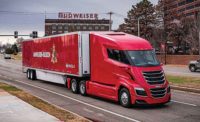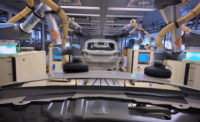The iconic Fiat 500 is a legendary automobile. In Italy, the cinquecento is considered to be the “people’s car.” Since 1957, more than 6 million units have been mass-produced. The subcompact vehicle is even part of the permanent collection of the Museum of Modern Art in New York City.
To bridge the past with the present, engineers recently developed a battery-powered version of the 500. It’s the first fully electric Fiat designed from the ground up.
The Fiat 500 is assembled at the historic Mirafiori plant in Turin. The 83-year-old facility is the flagship factory of Fiat parent Stellantis NV.
To produce the 500 EV, the Mirafiori factory received a €700 million facelift, including state-of-the-art technology such as collaborative robots. To automate a series of complex assembly line operations and quality controls, Stellantis installed 11 cobots from Universal Robots A/S.
Models chosen for the application include two UR5 robots, which feature an 11-pound payload capacity, and nine UR10 cobots, which can handle payloads up to 27.5 pounds. The machines perform a variety of assembly tasks, including dispensing, screwdriving, quality control and visual inspection.
Some of the assembly processes required the introduction of specific automation technologies to ensure the quality and repeatability needed to meet product standards. Another criteria was ergonomics, because of the average age of operators at the Mirafiori facility. The collaborative applications have addressed operating precision and quality, in addition to improving a series of production tasks previously performed manually.
“We decided to adopt collaborative robots some years ago,” says Ennio Meccia, head of manufacturing engineering at Stellantis. “[The] technology is a guarantee of a particularly advanced man-machine interface perfectly matched with [our] quality requirements in terms of both production processes and products. Collaborative automation has freed operators from repetitive and physically demanding manual tasks so that they can be employed on processes with greater added value.”
The collaborative robots were rolled out gradually to enable operators to fully understand and get comfortable with the automated processes.
“As a first step, we decided to introduce a cobot in the company canteen, distributing glasses of water to employees during their lunch break,” explains Luigi Barbieri, plant manager. “This gave workers the opportunity to see the collaborative nature of the cobots for themselves, and overcome any apprehensions about the safety of the subsequent applications.
After the success of this initial trial, the UR cobots were installed at seven workstations on the Fiat 500 EV assembly line.
Two UR10e cobots operate in parallel on the door assembly line. A vision system registers the arrival of each door and activates the cobot, which uses a roller attached to its wrist to apply constant pressure on a piece of fabric, applying it on the door panel.
According to Barbieri, the application is particularly challenging because it requires the robot to follow a complex path within a confined space, avoiding the panel’s push pin protrusions and ensuring that the liner is completely sealed to prevent the infiltration of water. The cobots work with a repeatability of ±0.05 millimeter.
“The [robots have] significantly improved the ergonomics of this application,” explains Giuseppe Guidone, an ergonomics specialist at Stellantis. “The application of the liner required the operator to apply constant pressure using a dynamometric roller, a task that over the long term could damage arm joints and cause musculoskeletal disease. So, the cobot has brought two benefits: high operating precision and quality, along with improved ergonomics and well-being for our operators.”
Two UR10e robots operate on the soft-top assembly line for the Cabrio version of the 500. The first machine performs two different operations. Using a pad supported by a special pick-up device, the cobot cleans and prepares the primer track, on which the adhesive to fix the soft top to the frame is subsequently applied. The second operation is quality control, where a vision system checks the geometric continuity and dimensions of the adhesive band.
The second cobot works in synergy with a traditional six-axis robot. Once the soft top has been assembled, it is opened on a special support and then picked up by the robot. At this point, the second cobot runs a size check (through a vision system) on the soft-top frame to ensure the conformity of the dimensions. Once tolerances have been confirmed, the soft top is removed from the line by the other six-axis robot.
“This application offers a series of productivity and quality advantages,” says Barbieri. “The cobots ensure that the adhesive extrusion is correct and check the dimensions of the soft-top frame.”
On the door assembly line for the Fiat 500 EV Cabrio, a UR10e robot has been configured to insert and set 10 blind break-stem rivets, which secure the trunk hinge reinforcements to the tailgate frame. An operator loads the tailgate frame and hinge reinforcements onto the workstation, then leaves the cobot to position and install the rivets.
“The application provides productivity and ergonomic benefits,” explains Barbieri. “At the same time, constant monitoring of the workstation input and output parameters ensures higher and consistent process quality.”
For the hood mounting application, a car body reaches the workstation with the hood mounted in a closed position and the hinge screws inserted by operators at the previous station. Once the hood geometry has been established, a UR10 robot moves into position and tightens four screws to the correct torque.
“The main advantages of this application are quality, efficiency and ergonomics, given that the hood reaches the station in a closed position, making correct tightening extremely difficult,” says Guidone. “Since the hinge screws to be tightened are not visible, the operator could easily miss one or [tighten a fastener incorrectly]. The cobot also improves the ergonomics of the operation, freeing operators from working in uncomfortable or awkward positions.”
Some Fiat 500 models feature an extra rear side door. To assemble it, an automated application capable of performing a complex tightening cycle is required. With the assistance of an automated tool on which the cobot is installed, the door is positioned correctly on the vehicle body. The robot then performs the tightening operation from the rear of the vehicle.
According to Guidone, the cobot meets two different process requirements. It frees operators from tightening the hinges in an awkward posture, where they would be unable to see the correct positions inside the car body. The robotic application also prevents kickback from the fastening tool, which operates with a torque of 75 newton-meters.
The mudguard mounting workstation uses four cobots. In this station, vehicles arrive with left and right mudguards already in position. A pair of UR5 and UR10 robots are attached to a platform that lowers itself on a vertical axis above the body.
The wings of the platform close to fix the geometry and activate the operation to tighten 24 screws that fasten the mudguards. Each of the four cobots is fitted with an automatic screwdriver equipped with torque control.
“This application offers various advantages,” claims Barbieri. “Collaborative automation guarantees ergonomic benefits for the operators, who are no longer required to work below the vehicle body. Since the screws [are tightened with torque control], tensile stress on the sheet metal parts is also eliminated. In addition, the cycle time is shortened, which boosts productivity.”














